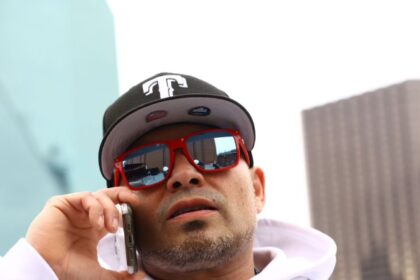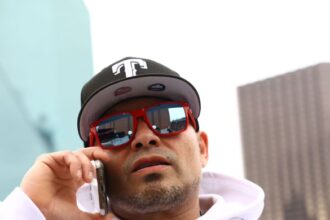LONDON — Rory McIlroy was hardly the first golf megastar to falter down the stretch of a major: see Arnold Palmer at the 1966 U.S. Open and Greg Norman at the 1996 Masters.
But for all the illustrious company, blowing a lead is still misery. McIlroy had not missed a putt inside three feet all season on the PGA Tour, and yet, with a one-stroke lead and the U.S. Open on the line at Pinehurst No. 2 in North Carolina last month, he missed a par putt from 2 feet 6 inches on the 16th hole. He then missed a putt on the 18th from 3 feet 9 inches.
Victory went instead to Bryson DeChambeau after a great escape from a bunker on the final hole.
McIlroy, still trying to end his decade-long major drought, could only stare desolately at the screen in the scorer’s room with his hands on his hips and then trudge to his courtesy car without further comment that day.
#Pinehurst quickly became a hashtag on social media.
“Yesterday was a tough day, probably the toughest I’ve had in my nearly 17 years as a professional golfer,” McIlroy posted on X the next day.
He has since withdrawn from the Travelers Championship to regroup and is set to return this week for the Genesis Scottish Open to defend his title. He will then play in the next major: the Open Championship.
How does a player recover from an experience like this, particularly when, in McIlroy’s case, it is not your first major breakdown? How does one move on from those missed short putts and get it right the next time?
Morris Pickens and Gio Valiante, two leading performance psychologists, have some answers. While they do not work with McIlroy, they have worked frequently with professional golfers.
The bottom line: It will be a daunting task, in part because McIlroy now has considerable scar tissue and because it is so difficult to replicate the kind of pressure that comes with needing to make a short putt to win a major.
“The closest thing that stands out is when you have a field goal to win the Super Bowl,” Pickens said in a telephone interview. “You just don’t get that opportunity very often. It’s not like a kick during the regular season.”
But Pickens, who has worked with major champions like Zach Johnson and Stewart Cink, said it was important to analyze a breakdown thoroughly and to confront failure rather than shy away from the pain.
Pickens said he would pull up video of the putts McIlroy had missed in pressure situations to see where the cracks formed. “It might be showing up in his stroke, but it’s not a technical thing,” he said. “The root cause is mental.”
The keys, he said, were for players to understand their patterns and when they surfaced. “We’re probably going to have to bring the caddie in,” Pickens said. “Because it’s maybe that you start talking faster or walking faster, or you stop eating or drinking enough.”
Pickens, who did his doctoral thesis on putting, tries to create artificial pressure for his clients.
Pickens uses a game called Distraction, where his clients have to block him out as he yells at them and moves around them. He also has his clients hit a putt after running sprints and doing push-ups, which he says helps them learn how to calm down and control their bodies after their heart rates are raised.
Pickens advocates two mind-sets. The first is that of a firefighter who “goes into this situation to do something good, not run out of the house because you don’t like the heat,” which should be adopted when approaching a putt. The second is a more robotic one that zeros in on the physical act and articulates it, which helps when it is time to hit the putt.
McIlroy’s putting has been a relative weakness compared with his long game, and he works with the putting coach Brad Faxon, an eight-time PGA Tour winner.
Faxon has underscored to McIlroy the importance of being instinctive and staying positive. When he spoke with Gary Player for Player’s podcast in 2021, Faxon said he had asked McIlroy to “write down or think about the feel of a great putt” that he had hit each day.
But when McIlroy needed it most at Pinehurst, his putting failed him, just as it did down the stretch at the 2023 U.S. Open when he finished second and at the 2022 British Open when he finished third.
“Putting is the game within the game,” said Valiante, who is also the author of “Fearless Golf” and has worked with Justin Rose and Jordan Spieth. “The problem with putting is it’s disproportionately punishing. You can just be fractionally off and do what we saw Rory do. It’s unequivocally the most psychological part of the game, and putting literally lives in a different part of the brain.”
The brain, Valiante said, has evolved to emphasize traumatic experiences, which could include the embarrassment of missing a “gimme” putt with millions watching.
“The brain starts saturating the neural network with adrenaline, which is basically the equivalent of using a yellow highlighter,” he said. “If you’re out there trying to survive and something scary or dangerous happens, your survival depends on you not making that mistake again. So the brain is doing what it’s designed to do: It’s learning. The problem is that’s good in evolution, but really, really bad in a game like golf.”
Flashing back to a painful memory is not just mental, Valiante said, it’s physical.
“The heart rate goes up, the muscles tighten and pupils dilate,” he said. “The episodic memories don’t get better with time. They live in the unconscious mind and so the problem is the next time Rory is in contention at a U.S. Open, the physiological response his body is going to have — I’m not saying might have, I’m saying it will happen — is going to be extreme. And he’s going to have to battle it.”
Palmer never won another major after losing a six-shot lead with six holes to play at the 1966 U.S. Open. Neither did Norman after losing his six-shot lead in the final round of the 1996 Masters.
But there are happier endings. In 2012, In-Kyung Kim missed a 14-inch putt that would have secured her first major victory at the Kraft Nabisco Championship. Five years later, Kim won the Women’s British Open.
“It’s a long process to get over 2012,” she said after her win. “A lot of people helped me. Now I enjoy playing golf again. What it did teach me is to give the same effort to every shot, even the shortest of putts.”
McIlroy, who blew a four-shot lead at the 2011 Masters with a final-round 80, bounced back to win the U.S. Open that year and then won three more majors before this 10-year drought.
He is still, at 35, in his prime, but he is also experienced enough to have lots of baggage, some of it now tagged “Pinehurst.”
“Good feedback is good feedback, but what I’d emphasize is that bad feedback is also good feedback,” Pickens said. “We can make progress with this. That’s why I don’t think it’d be helpful to brush it under the rug or try to deny it, because you’re good enough and young enough that you’re probably going to have more chances at majors. So, let’s do the painful things.”








